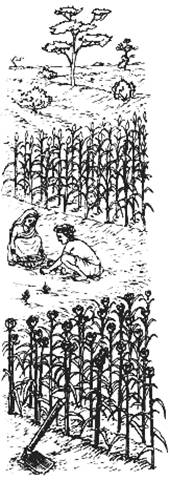
Soil and water conservation measures consist of agronomical and mechanical methods. Agronomic methods are supported with mechanical measures where land slope exceeds permissible limits and runoff gains erosive velocities.
The following boxes explain the nature of agronomic measures which are essential in inter-bunded or terraced areas. These practices enhance the utility value of all kinds of mechanical structures.
Contour Tillage
All agricultural operations such as ridging, ploughing, harrowing, sowing, trenching, etc., are recommended to be done on the contour wherever possible or at least generally across the direction of the slope where holdings are very small. Even though the operation is very simple, it plays a major role in retarding the process of soil erosion through runoff. It also conserves soil, and due to increased time of concentration, more rainwater seeps through the soil profile to recharge ground water. Summer ploughing leaves the soil highly absorbent of initial rains.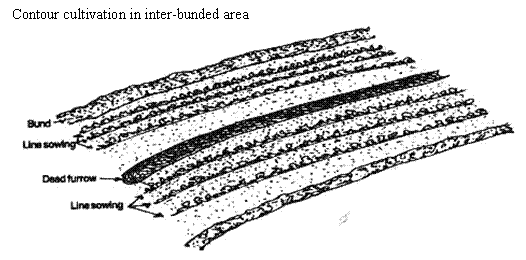
Dead Furrows
When all tillage operations are complete, it is advisable to leave a deep dead furrow at every 10 m interval. This should remain in position until the crop is harvested. Dead furrows aid in reducing the runoff velocity and they also conserve water.
Organic Matter
Indian soils are very poor in organic matter, especially in drought-prone areas. This can be improved by leaving the crop residue in situ (on the fields).
Adding organic manures such as farmyard manure and compost every year as basal application to the soil improves the physical condition of the soil considerably. Soil – Air, Soil – Temperature, and Soil – Moisture relationships are well balanced with the presence of organic matter. Organic matter improves the activities of soil microorganisms and also provides the much needed micro plant nutrients of all kinds, besides nitrogen, phosphorus and potash.
Addition of large amounts of chemical fertilizers to dryland crops should be discouraged as it damages the soil due to:
- excessive depletion of scarce soil moisture for its own transformation;
- reduction in all soil microorganism activity; and
- destruction of soil structure
Selection of Drought-Resistant Varieties
It is important that varieties which have proven genetic character to withstand longer periods of drought are chosen so that the crops can do well even in situations where the intervals between rainy days are long.
Early Maturing Varieties
Where the distribution and the amount of rain is unpredictable, it is important to select varieties which have a shorter duration life cycle (seed to seed) to cut down the water requirements of the crop. In drought-prone areas, the success rate of short duration crops is greater than long-duration crops.
Strip Cropping
Raising Erosion Permitting Crops (EPC) with Erosion Resistant Crops (ERC) having abundant adventitious root system and providing high percentage of canopy in strips in a ratio of 2:1 or 3:1 (i.e. 20 to 10 rows or 30 to 10 rows) helps in trapping soil from EPC strips to ERC strips
The increased resistance to runoff in ERC results in higher volume of water percolating through soil profile, due to increased time of (on-ground) concentration.
The close-growing ERC strips are generally legumes which fix nitrogen in the soil and enrich it.
The canopy of the ERC also protects the soil from beating action of rain drops.
Strip cropping also helps in stabilizing crop production.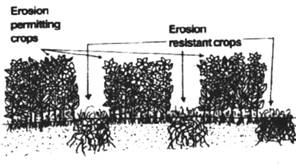
Wind Erosion
Wind Erosion is as important as water erosion, the same system of cropping is recommended to be adopted, generally across the wind direction. Farmers can also raise wind belts across the wind direction. Alley cropping with rows of trees at 30 to 45m intervals also controls the desiccating effects of hot and dry winds.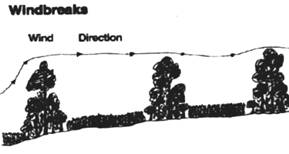
Agro-horticulture
Marginal lands do not produce good annual crop returns even in normal season. These kinds of soils are best used for raising trees of economic value and creating permanent assets. Some of these lands are also very good for raising dryland horticultural crops such as mango, ber, pomegranate, tamarind etc. A part of the land could be earmarked specially for planting mixed tree species known in the area for providing fuel, fodder and timber for household needs and agricultural implements. Trees provide stable and sustained income every year, especially in drought years.
Role of Vegetation
Vegetation is crucial in preserving productive soil and conserving rain water for sustaining life. Soil and water need to be preserved for crop production (both annual and plantation crops) as well as plants that give fuel, fodder, fruits, industrial raw materials, medicinal and aromatic plants and the like.
Minor vegetation such as creepers, shrubs, various kind of grasses, legumes and plants like Agave, which yield fibre have an important role when grown in gullies of various kinds and also on upstream and downstream sides of mechanical structures such as gully checks, water harvesting structures, etc. These provide reinforcement and extend the life span of the structures by binding the soil through the network of their root systems. These plants also provide fodder to animals in the area.
Seed Rates
Normal season : Sowing is done with the normal seed rate. However, if there is a drought during the plant’s growth period and wilting is likely to occur, selective thinning is recommended to reduce the plant population to effectively use the scarce soil moisture among fewer plants.
Late season : Where the monsoon is moderately delayed, normal cropping with reduced seed rate is advised.
Line Sowing
Line-sowing on contours is essential. It arrests runoff and conserves soil being eroded. It helps in the use of labour-efficient implements in weeding (i.e., removal of unwanted vegetation through use of different sizes of blade harrows between the rows).
Wider Spacing
In all drought-prone areas, the most important objective is to raise a successful crop under scarce soil moisture conditions. One of the recommended practices is wider spacing between rows and between plants within the row. This reduces plant population and competition between plants for scarce soil moisture. Fewer plants have greater access to limited available soil moisture.
Weeding
Frequent weeding is an important part of dryland agriculture. Line sowing and mechanical weeding, with appropriate size of blade harrows, remove unwanted vegetation which competes with the main crop. It is not uncommon to see the dryland farmer hitching several blade harrows to one yoke and a pair of bullocks. Weeding within rows can be done using hand hoes. Removal of unwanted vegetation helps the main crop obtain greater accessibility to soil moisture and plant nutrients for its own growth.
Mixed/Inter Cropping
Mixed cropping of different crops along with the main crops, such as millets and different legumes, is an insurance against the vagaries of the monsoon. The different root systems of mixed crop feed at different depths of the soil. Moreover, mixing cropping provides small quantities of grain of different kinds for home consumption at different times.
Mulching
Mulches are ground covers that prevent the soil from being washed away, reduce evaporation, increase infiltration, and control growth of unwanted weeds. Mulch can be organic crop residue, pebbles, or materials such as polythene sheets. Mulching prevents the formation of hard crust after each rain. Organic mulches add plant nutrients to soil upon decomposition. Use of blade harrows between rows also creates “dust mulch” by breaking the continuity of capillary tubes of soil moisture.
Contingent Planning
With every care taken to undertake timely agricultural operations, it is still possible that the whole operation becomes a gamble due to unpredictable monsoons. The main crop could fall in the early part of its life cycle. In such cases, the farmer should come up with an alternate crop that can mature in a very short time and under hard conditions to take advantage of what is left of the rainy season. Contingent planning helps catch and make the best use of late rains. Advance planning is necessary in selecting a contingent crop. And all the requisites for its sowing should be ready within the main season itself. Credit for farmers must be made available at the right time.
Buffer Strips
In steep slopes and highly-eroded soils, raising permanent vegetation in small strips at appropriate intervals along the contour helps in arresting soil erosion and conservation of rain water. Raising trees in buffer strips is an asset to counter unpredictable monsoons.
Mechanical Methods
Where the slope of the soil is more than permissible, mechanical measures such as bunding, terracing and trenching are recommended in addition to agronomic methods. Agronomic methods are used in inter-bunded areas and mechanical practices complement to help boost crop yields in rainfed drylands.
Indigenous technical knowledge
Local technologies evolved by people over generations of experience should be used before any new recommendation is made.
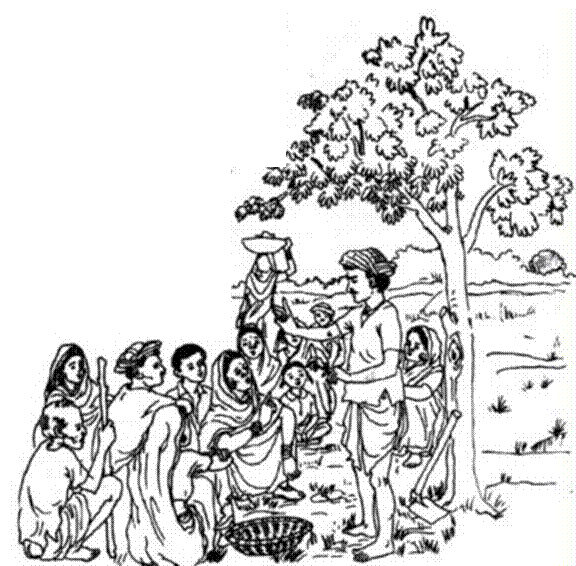
/articles/agronomic-measures-dryland-agriculture-overview